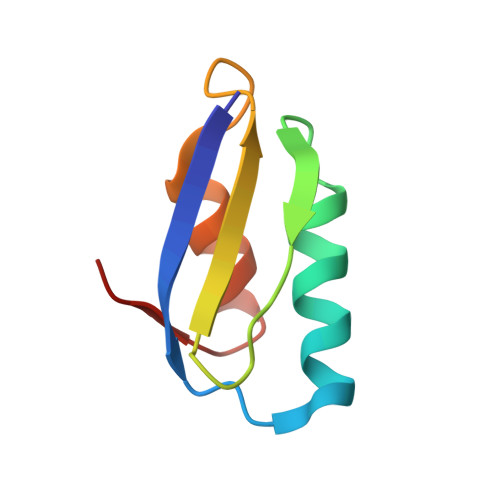Mechanistic insights into Cu(I) cluster transfer between the chaperone CopZ and its cognate Cu(I)-transporting P-type ATPase, CopA.
Singleton, C., Hearnshaw, S., Zhou, L., Le Brun, N.E., Hemmings, A.M.(2009) Biochem J 424: 347-356
- PubMed: 19751213
- DOI: https://doi.org/10.1042/BJ20091079
- Primary Citation of Related Structures:
3I9Z - PubMed Abstract:
Multinuclear Cu(I) clusters are common in nature, but little is known about their formation or transfer between proteins. CopZ and CopA from Bacillus subtilis, which are involved in a copper-efflux pathway, both readily accommodate multinuclear Cu(I) clusters. Using the luminescence properties of a multinuclear Cu(I)-bound form of the two N-terminal soluble domains of CopA (CopAab) we have investigated the thermodynamic and kinetic properties of cluster formation and loss. We demonstrate that Cu(I)-bound forms of dimeric CopZ containing more than one Cu(I) per CopZ monomer can transfer Cu(I) to apo-CopAab, leading to the formation of luminescent dimeric CopAab. Kinetic studies demonstrated that transfer is a first-order process and that the rate-determining steps for transfer from CopZ to CopAab and vice versa are different processes. The rate of formation of luminescent CopAab via transfer of Cu(I) from CopZ was more rapid than that observed when Cu(I) was added 'directly' from solution or in complex with a cysteine variant of CopZ, indicating that transfer occurs via a transient protein-protein complex. Such a complex would probably require the interaction of at least one domain of CopAab with the CopZ dimer. Insight into how such a complex might form is provided by the high resolution crystal structure of Cu3(CopZ)3, a thus far unique trimeric form of CopZ containing a trinuclear Cu(I) cluster. Modelling studies showed that one of the CopZ monomers can be substituted for either domain of CopAab, resulting in a heterotrimer, thus providing a model for a 'trapped' copper exchange complex.
Organizational Affiliation:
Centre for Molecular and Structural Biochemistry, School of Chemistry, University of East Anglia, Norwich NR4 7TJ, UK.















